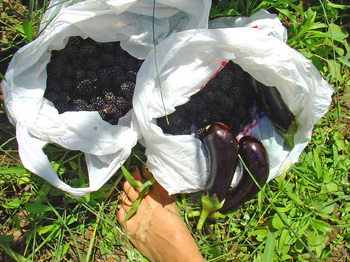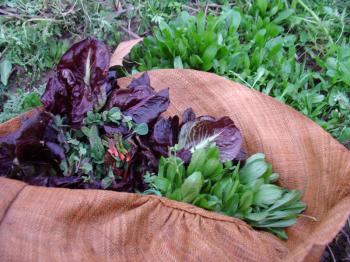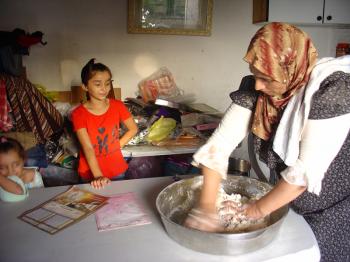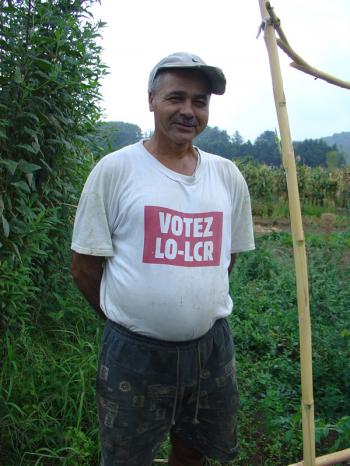Survival through dehydration
November 4, 2008
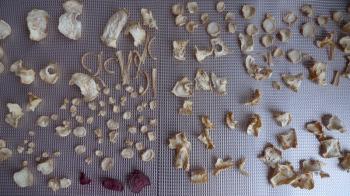
Looks like rat tails and bones. Guess I’m just getting visually prepared for the future!
Well if the whole world goes to pot (and not in the good way) at least I will have dehydrated exactly 2 days worth of essential parsley root. And if I keep at it, soon I’ll have saved enough celeriac chips to barter myself a dirty vodka martini.
No offense Mormons and Survivalists, but as much as I adore playing with my food and eating like a Tibetan nun, I’m having a hard time finding the sexiness in dehydrating personal stores of food. In the mean time, I’m taking this cool dehydrator tool for a spin, though in my heart I prefer a community pickle and a community solution. Maybe I should have dessicated something a bit more joyous than beige roots or things perfectly capable of preserving themselves. Maybe I’ll revisit the raw food folks. Despite the rhetoric, they do the cuisine vĂ©gètal a nice turn.
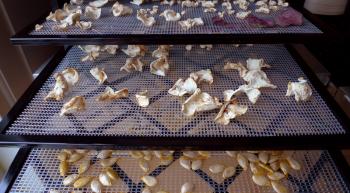
Handy-to-mouthy for drying pumpkin seeds. In case I ever run out.
I’m not knocking the Excalibur. Technically and visually it’s handy as Hell, but it would be a dang sight handier if I had big batches of summer fruit to process. Anyway, I’m banking on my kimchi making skills to get me through the Apocalypse. Denial?
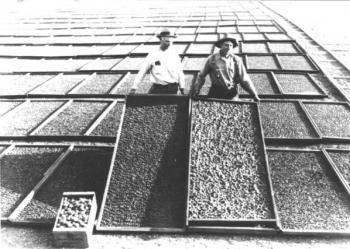
Apricot drying in the Old Country, back in the day. Image used entirely without permission.
If I remember correctly, as a kid growing up in California, we used to dry the family’s summer haul of apricots, plums and figs on large redwood trays delivered to the house. (M & D, how did that work? Did the trays stay? Was it a municipal service for apricot-rich people? Are you out voting correctly right now?)
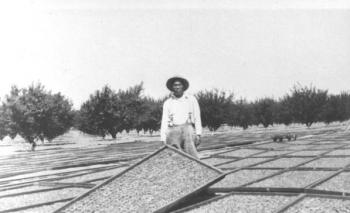
Cots and cots, as far as the eye can see. Image used entirely without permission.
Today, KvR and I agreed that all of these high-end kitchen tools need to be about increasing joy and variety in the belly, not about merely surviving or practicing deprivation. It’s not the Excalibur’s fault that it’s hugely popular amongst overly sober goat-knitters. But food flow begets food flow, and a cook in the habit of ‘moving’ food is certainly the most resilient in any type of crisis. Yes, us urbanites living in cities’ with a mere 4 days of food in store for us, most of it in transit, are wise to be prepared for transitions and downturns. Like Sharon Astyk says, your skill as a versatile cook will be your most important tool.
Surviving the New Depression: Tip #43
Steve Delahoyd made a series of ‘Just get on with it’ videos, this one is about New Local Economic Transactions.
But seriously…
Historic images of Sunnyvale in Santa Clara County California (a Blue State) where, ‘It used to be ALL orchard.’Transition Culture dot org, Robert Hopkins is an expert without being gloomy.
The Excalibur Dehydrator - the definitive food dryer
Juliano’s recipes using the dehydrator have lots of joy, if not evangelical zeal.
debra at 20:39 | Comments (2) | post to del.icio.us
Communauté Choucroute, Community Pickle,
a proposal
October 30, 2008
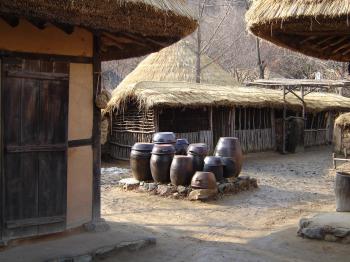
Jangdok are onggi or earthen jars storing jang (condiments) such as gochujang (chili pepper condiment), doenjang (soybean paste), ganjang (Korean soy sauce) or kimchi. Image from Save the Dinosaur’s photostream and used entirely without permission.
The following is a statement about food storage that I will be presenting this year as part of John Thackara’s City Eco Lab at the Cité du Design Biënale in Saint-Étienne (Nov 15-30, 2008). Chef Paul Freestone and I will be pickling, sauerchocrouting and making delicious kimchi as one part of the installation. Please come visit the exhibition and taste what I’m proposing for the resilience of our communities.
Food sovereignty refers to the right of people to define and to have access to their own food and agriculture systems in contrast to having food largely subject to international market forces or defined by the dynamics of industrial food production. Designing community food storage into our cities and towns has enormous potential to reduce waste, shorten supply chains and on a socio-cultural level improve our communities.
Start imagining public food storage as part of urban masterplans, how it could look (and smell) and what it would mean in terms of activity and focus for the community. Before you discount this notion as completely comical, are you aware of how your community stores its food presently, how resilient it is in case of damage to the transport network, market forces, or how dependent your food is on foreign resource supplies?
In Europe, our backup food supply is most often stored en route, in trucks on the road. The fermented vegetable installation and demonstration, Communauté Choucroute is a proposal inspired by places in Asia where pickled vegetables are stored in beautiful ceramic vats in the open air, in the public space, ready for when you need it.
For greater food sovereignty, let’s store food around us, in our communities.
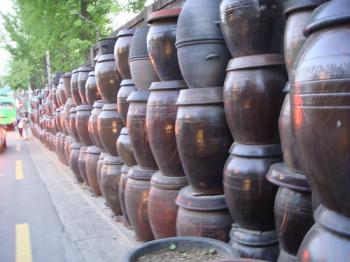
Kimchi pots stored along the side of a busy road, image from Jwh8a’s photostream on FlickR and used entirely without permission.

Kimchi pots stored along the side of a busy road, image from AtDawnWeRide’s photostream on Flickr and used entirely without permission.
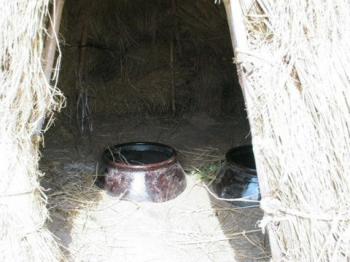
Kimchi pots buried in straw, image from Makigama’s photostream on Flickr and used entirely without permission.

Kimchi pots aka onggi displayed as a choir, image from mmgutz16’s photostream on Flickr and used entirely without permission.
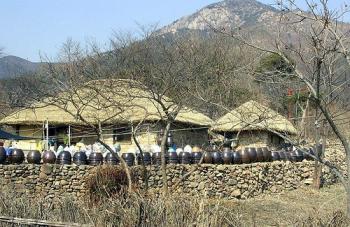
Kimchi pots lining the periphery of a folk village, image from Carpe Feline’s photostream on FlickR and used entirely without permission.
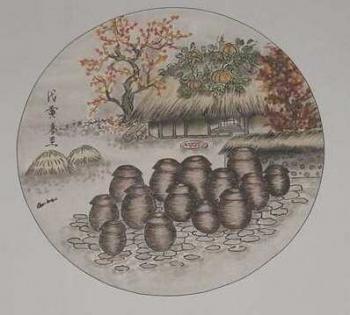
Pen and ink drawing of kimchi pots stored in the public space and pumpkins growing on a thatched roof. Photo snapped by Carpe Feline and used entirely without permission.
-
Save the Dinosaurs photostream on Flickr - images of a.o.t. a visit to a folk village and of course some kimchi pots being stored in the village square.
Jwh8a’s image of kimchi pots on Flickr.
AtDawnWeRide’s photostream on Flickr - kimchi pots stored and stacked alongside the road.
Makigama’s photostream on Flickr - a ceramophile and kimchi-o-phile
debra at 16:48 | Comments (1) | post to del.icio.us
A Kimchi Sunday
October 27, 2008
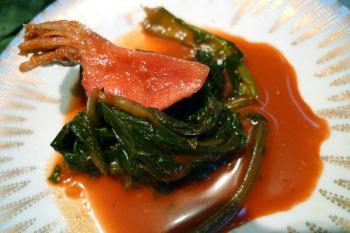
Turnip and turnip leaf kimchi in a pool of sauce shaped like the silhouette of a kimchi-lover
Community/Communauté Choucroute is one of my proposals at the City Eco Lab in Saint-Étienne for the Design Biennial this November. Designing resilience into urban food systems is essential, and one way to achieve this is to store food en plein public. There’s precedence in the salted and/or pickled cabbage installations centered in traditional villages and along the roadside in parts of East Asia.
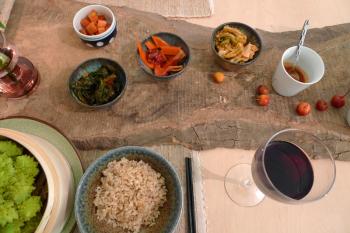
Kimchi array from l to r: daikon cubes, turnip greens, carrots and chard stems, chinese/napa cabbage, kimchi juice for extra rice lubrication
In preparation for the installation/demonstration of Communauté Choucroute, I’ve been experimenting with different fermented vegetable recipes. And when my landscape-architect friend Jacques decided that our shared passion for Korean pickled cabbage/kimchi as a way of spending a Sunday for us to get better acquainted, it was nothing short of prescient. Jacques prepared an exquisite workshop for us that included an instructional video from our online mentor Maangchi and all manner of traditional kimchi vegetables.
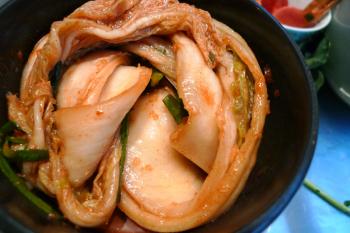
Classic chinese/napa cabbage kimchi
Although I’ve been making kimchi for decades, in my laziness I had resorted to using a pre-fab Korean kimchi paste from the Chinese supermarket. The flavours were good on their own, but not like the kimchi from a great Korean restaurant. Jacques introduced me to the ease of preparing the kimchi paste myself and an easier, faster recipe. Pardon my sounding like an advert when I gush that the results were astounding - perfect kimchi, 100% authentic flavour, in a fraction of the time. It’s like when you figure out how to roll your own pasta in 20 minutes, there’s no going back to storebought. Within a day our kimchi was bubbling away with a flavour so rounded with umami that I feel inspired to open up a kimchi boutique. The new secret ingredient? Chopped up raw oysters and all the sweet oyster juices. I am certain that it’s this enzyme-rich liquor that together with the lacto-bacilli-beasties transforms mere rotting vegetable matter into the champagne of cuisine vegetal.
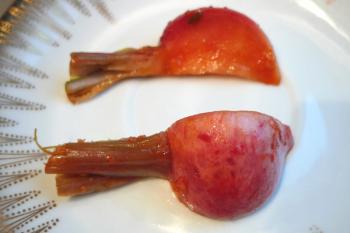
Kimchi turnips like jewels on a plate.
-
Maangchi’s instructional kimchi video
Culiblog’s step by step kimchi on Flickr
Valuable information and beautiful images from the Nation of Kimchi
debra at 11:49 | Comments (8) | post to del.icio.us

